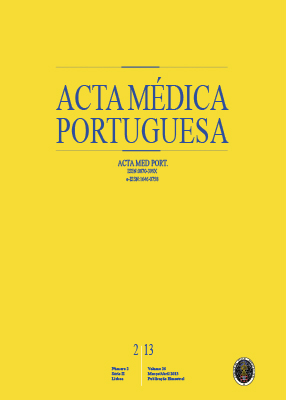Predicting Outcome after Cardiopulmonary Arrest in Therapeutic Hypothermia Patients: Clinical, Electrophysiological and Imaging Prognosticators
DOI:
https://doi.org/10.20344/amp.203Abstract
Introduction: Predicting outcome in comatose survivors of cardiac arrest is based on data validated by guidelines that were established before the era of therapeutic hypothermia. We sought to evaluate the predictive value of clinical, electrophysiological and imaging data on patients submitted to therapeutic hypothermia. Materials and Methods: A retrospective analysis of consecutive patients receiving therapeutic hypothermia during years 2010 and 2011 was made. Neurological examination, somatosensory evoked potentials, auditory evoked potentials, electroencephalography and brain magnetic resonance imaging were obtained during the first 72 hours. Glasgow Outcome Scale at 6 months, dichotomized into bad outcome (grades 1 and 2) and good outcome (grades 3, 4 and 5), was defined as the primary outcome. Results: A total of 26 patients were studied. Absent pupillary light reflex, absent corneal and oculocephalic reflexes, absent N20 responses on evoked potentials and myoclonic status epilepticus showed no false-positives in predicting bad outcome. A malignant electroencephalographic pattern was also associated with a bad outcome (p = 0.05), with no false-positives. Two patients with a good outcome showed motor responses no better than extension (false-positive rate of 25%, p = 0.008) within 72 hours, both of them requiring prolonged sedation. Imaging findings of brain ischemia did not correlate with outcome. Discussion: Absent pupillary, corneal and oculocephalic reflexes, absent N20 responses and a malignant electroencephalographic pattern all remain accurate predictors of poor outcome in cardiac arrest patients submitted to therapeutic hypothermia. Conclusion: Prolonged sedation beyond the hypothermia period may confound prediction strength of motor responses.
Downloads
Downloads
Published
How to Cite
Issue
Section
License
All the articles published in the AMP are open access and comply with the requirements of funding agencies or academic institutions. The AMP is governed by the terms of the Creative Commons ‘Attribution – Non-Commercial Use - (CC-BY-NC)’ license, regarding the use by third parties.
It is the author’s responsibility to obtain approval for the reproduction of figures, tables, etc. from other publications.
Upon acceptance of an article for publication, the authors will be asked to complete the ICMJE “Copyright Liability and Copyright Sharing Statement “(http://www.actamedicaportuguesa.com/info/AMP-NormasPublicacao.pdf) and the “Declaration of Potential Conflicts of Interest” (http:// www.icmje.org/conflicts-of-interest). An e-mail will be sent to the corresponding author to acknowledge receipt of the manuscript.
After publication, the authors are authorised to make their articles available in repositories of their institutions of origin, as long as they always mention where they were published and according to the Creative Commons license.









